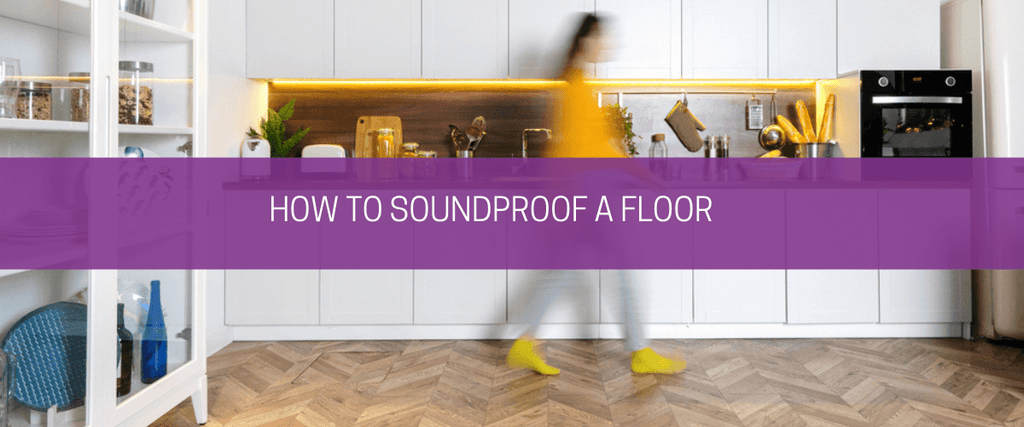How to soundproof a floor

Noise. It can be a real nuisance.
Perhaps you’re blighted with rowdy neighbours? Last year, there was a sharp 67% rise in noise complaints to the police – with loud voices, shouting, TV noise and music said to be the most common annoyances. Or maybe your household is the culprit? And you’re concerned about what the family in the flat below can hear when you’re all at home?
Either way, the solution could be as simple as soundproofing your floor.
Whether you have carpet, laminate, hardwood, or vinyl tiles, there are a few clever tricks that you can use to dampen any sounds and improve the acoustics in your home.
Impact vs airborne noise reduction
First things first – before you start to soundproof your floor – it’s important to know the difference between the two types of noise you’re looking to address. These include:
1. Impact noise
Also known as ‘footfall noise’. This type of noise occurs when there’s an actual physical impact or force applied to the surface of a floor. For example, it could be the sound of footsteps, moving furniture, or something that’s been accidentally dropped.
The impact – whatever it may be – creates vibrations, which then travel through the floor, emanating into the room below.
2. Airborne noise
Any sound that travels through the air, and is not caused by two objects hitting each other, is known as an airborne sound. Common household examples include noise from a TV or radio, people talking or shouting, dogs barking, coughing, a flushing toilet etc. And again, if the noise is loud enough, the vibrations will travel easily through the floor into the room underneath.
To soundproof your floor effectively, it’s important to tackle both of these types – adding soft sound-absorbing materials to disrupt the transfer of impact noise and dense, heavy materials to block airborne sounds.

4 ways to soundproof your floor on a budget
1. Acoustic underlay
Acoustic underlay is (by far!) the easiest way to soundproof your floor. By adding an extra layer of cushioning between the floor covering and subfloor, it creates an effective sound barrier – and most underlays will reduce impact and airborne noises by 30-40dB (decibels) or more. The best soundproofing underlay for you will depend on your type of flooring.

For those with carpets, our advice is to opt for Plushwalk 12mm. This is regarded as the best carpet underlay currently on the market.
Made from luxury memory foam, it boasts a range of superior features and can significantly reduce sounds by 49dB. Available for just £6.99 per m2, it offers an affordable and effective soundproofing solution.

For those looking to soundproof laminate or hardwood, we recommend Royale 7mm Professional Sonic Gold Underlay – available for £6.95 per m2.
Thanks to its unique ‘AeroFoam’ structure, this provides excellent sound insulation – and, impressively, it can reduce impact and airborne noise by up to 37dB.
2. Carpets and rugs
It goes without saying, carpet is the best type of flooring to turn down the noise in your home.
But if you’d prefer to stick to laminate or hardwood, rugs are also a great option – particularly those which are thick and tightly woven. Not only will they enhance your décor, they act as a fantastic sound-dampening tool – muffling any impact sounds, absorbing airborne noises and reducing echo.

3. Mass Loaded Vinyl (MSL)
MSL is a dense layer of rubber, which can be cut to size and installed underneath your floor covering.
Designed specifically for soundproofing purposes, it offers excellent sound insulation – typically around the 30dB mark. And if used in conjunction with an acoustic underlay, such as those mentioned above, it will block most (if not all) impact and airborne noises.
Because it’s so thick and heavy, MSL can be a bit tricky to install. But it will make a huge difference to the level of noise in your home, and in most cases, is worth the time and effort.
4. Use furnishings wisely
An empty room is always louder than one that’s filled with furniture. Soft furnishings, in particular, can successfully absorb both impact and airborne noises. Therefore, if you’re looking to improve the acoustics of a room, it may be worth adding a couple of extra pieces.
Don’t worry, we’re not suggesting you cram in another 3-seater sofa. Some additional throw pillows, a new set of thick curtains, or an ottoman bench would do the trick. And for bonus sound-dampening, simply place a piece of foam between your furniture and the wall. It may sound silly, but it can make a big difference.
Soundproof underlay available at Carpet Underlay Shop
As part of our extensive online collection, we stock a wide range of acoustic underlays for use with carpets, wood, laminate and vinyl. All of which are high-performance – capable of reducing impact and airborne noises by 30-40dB or more – and available for a competitive price.
So why not have a look and take the first step towards creating a quieter home, for both you and your neighbours?
To find out more about our soundproof underlays – or for further advice on how to soundproof a floor – please feel free to get in touch. Our team of experts are always on hand and happy to help with your enquiries. Just give us a call on 0203 887 0994 or send an email to sales@carpet-underlay-shop.co.uk and we’ll get back to you as soon as possible.
- Alex Illidge






